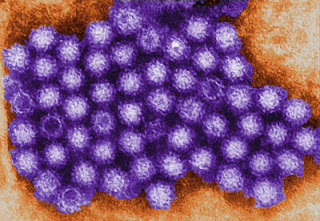Noroviruses are transmitted directly from person to person and indirectly via contaminated fomites, water and food. They are highly contagious, with as few as one to ten virus particles being able to cause infection.
Transmission the norovirus occurs through ingesting contaminated food and water and by person-to-person spread. Transmission is through fecal-oral, can be aerosolized when those stricken with the illness vomit and can be aerosolized by a toilet flush when vomit or diarrhea is present; infection can follow eating food or breathing air near an episode of vomiting. The viruses continue to be shed after symptoms have subsided and shedding can still be detected many weeks after infection.
Norovirus is extremely infectious. A CDC study of eleven outbreaks in New York State lists the suspected mode of transmission as person-to-person in seven outbreaks, foodborne in two, waterborne in one, and one unknown. The source of waterborne outbreaks may include water from municipal supplies, wells, recreational lakes, swimming pools and ice machines.
Shellfish and salad ingredients are the foods most often implicated in norovirus outbreaks. Ingestion of shellfish that have not been sufficiently heated poses a high risk for norovirus infection. Foods other than shellfish may be contaminated by infected food handlers.
Unlike many other viruses, people do not develop an immunity to norovirus and can become sick again.
Unlike many other viruses, people do not develop an immunity to norovirus and can become sick again.



 Posted in:
Posted in: 


0 comentarios:
Post a Comment